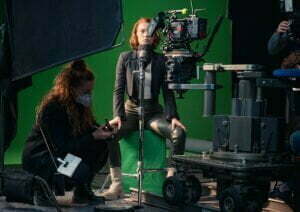Animation of images is a special art form within film production. It defies laws, changes them and creates completely new perspectives. Thanks to the various animation techniques and modern technologies, there are hardly any limits to creativity.
Animation makes it possible to make things appear to be true that do not exist and carries the audience off into their own worlds. Das R&, the film production company from Vienna, also works with animated images and gives your film project special expressiveness in this way.
Contents
Animation in film
Even before the invention of film and photography, there were first attempts to give life to images in 1825. Back then it was mainly rotating disks that were used to mislead the human eye.
However, it was almost 100 years before caricaturist and comic artist Winsor McCay created the first drawn animation film in 1911 and showed it to an audience on the big screen. Animated films began their great triumphant advance in the late 1920s in the form of Mickey Mouse.
Even today, the film production from Vienna uses some old technology in modified form and complements it with modern technologies for unique results.
The different forms of animation
Animation experts use a selection of six different forms of animation.
- 2D animation
- 3D animation
- 3D computer animation
- Kneading animation or clay motion
- Pixilation, a variant of the puppet show
The various forms of animation differ in the animation techniques used and their effect as a moving image.
2D animation
Cartoons are certainly one of the best-known representatives of 2D animation. But also techniques that serve as the basis for the animation film, flat figure film and silhouette film are still used as a design element today.
The most widespread form of animation is the cartoon. For decades, every drawing was created in detailed work by talented drawing artists. In the 1990s, 2D computer animation took over a large part of the manual work carried out on paper or foils.
Nevertheless, it is still not possible today without the talent of the illustrators. Even though the software handles numerous intermediate phases of creation, the key phases are still created by the artist.

The short stop animation film uses the short stop animation technique. The movement of the objects shown is simulated and recorded by manually moving them to other positions. The film is created by stringing together the numerous individual images. A well-known example is the animated film “The Mysterious Matchbox” produced by the German cameraman Guido Seeber in 1909.
The flat figure and silhouette film variants are also based on the short stop technique. The flat-figure film is extremely inexpensive to produce and uses photos or drawn and cut-out figures to illustrate various facts.
The silhouette film is the cinematic realisation of the well-known shadow game using various figures made of paper, cardboard or leather. The shadow projected onto a surface is recorded as a single image in the various positions and sequences of a scene. The sum of the numerous individual photographs ultimately results in the moving images.
3D animation
3D animation differs from 2D animation in that it uses three-dimensional objects and figures that move on all axes. Stop motion animation technology is used to produce realistic images. 3D animation is not only the oldest, but also the easiest way to bring a three-dimensional figure to life.
If this technology is used in video production, a realistic model of the object or figure is made beforehand. The individual movements of these models are recorded as individual shots and finally integrated into the real film scenes.
This very simple animation technique is still extremely popular today and is also used in our film production to achieve special effects at low cost.
Kneading animation or claymation
Who doesn’t know the funny “Plonsters”, who roll across the screen, constantly take on new forms and are extremely expressive. The basis is usually simple plasticine or a similarly pliable modelling clay, from which the animation specialists shape the figures and objects.
The stop motion animation technique is used for the kneading animation. All movements are recorded in individual images and later put together to make a film. Among the best-known film productions that used clay animation, apart from “Plonsters“, are the films “Shaun the Sheep – The Movie“, “Chicken Run” and “Wallace & Gromit“.
Pixilation – a variation on the puppet film
While in the puppet film marionettes, hand puppets or other models come to life through animation, the animation form pixilation uses people who are photographed in the form of numerous individual images for the film or video production.
The result is an expressive representation of the most varied of situations, which is so unique mainly through the creative design element of the movements, which mostly deviate from normality. A very successful example of a pixilation film is Norman McLaren’s film “Neighbours“.
3D computer animation
Animation reached the latest milestone in development with 3D computer animation. It opened up previously unknown possibilities in the context of video and film production. Whether in Vienna or Hollywood: Suddenly the realization of creative ideas seemed limitless.
Cartoons in particular were revolutionized as a result. Suddenly the figures generated on the computer acquired a personality and activity that were previously unattainable. The first full-length animated film was “Toy Story“, which was just the beginning of a success story. Successful films such as “Ice Age“, “Cars” and “Paw Patrol” followed.

The computer technology required for this has developed rapidly since 1995. For example, 100 computers were required for Toy Story, which calculated over 110,000 individual images in around 800,000 hours. But even today, the production time of an animated film is estimated at four to five years. After all, despite the most modern and powerful technology, six hours of working time are behind one second of film.
Animation as an indispensable element of film and video production
Animation is now an essential part of a wide variety of films and videos. Regardless of whether it is an advertisting film, a product presentation, entertainment films or the presentation of animated graphics during a meeting with business partners. There is the ideal animation technique for every requirement, with which you can achieve exactly the effect or statement that you are looking for in your video.
As a film production company from Vienna, the team of experts at Das R& knows the numerous ways to bring images to life through animation and give the content additional creativity and expressiveness, making your video or film project a success.
More information:
Visual Effects Vienna







